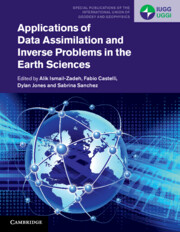Book contents
- Applications of Data Assimilation and Inverse Problems in the Earth Sciences
- Series page
- Applications of Data Assimilation and Inverse Problems in the Earth Sciences
- Copyright page
- Contents
- Contributors
- Preface
- Acknowledgements
- Part I Introduction
- Part II ‘Fluid’ Earth Applications: From the Surface to the Space
- 5 Data Assimilation of Seasonal Snow
- 6 Data Assimilation in Glaciology
- 7 Data Assimilation in Hydrological Sciences
- 8 Data Assimilation and Inverse Modelling of Atmospheric Trace Constituents
- 9 Data Assimilation of Volcanic Clouds: Recent Advances and Implications on Operational Forecasts
- 10 Data Assimilation in the Near-Earth Electron Radiation Environment
- Part III ‘Solid’ Earth Applications: From the Surface to the Core
- Index
- References
10 - Data Assimilation in the Near-Earth Electron Radiation Environment
from Part II - ‘Fluid’ Earth Applications: From the Surface to the Space
Published online by Cambridge University Press: 20 June 2023
- Applications of Data Assimilation and Inverse Problems in the Earth Sciences
- Series page
- Applications of Data Assimilation and Inverse Problems in the Earth Sciences
- Copyright page
- Contents
- Contributors
- Preface
- Acknowledgements
- Part I Introduction
- Part II ‘Fluid’ Earth Applications: From the Surface to the Space
- 5 Data Assimilation of Seasonal Snow
- 6 Data Assimilation in Glaciology
- 7 Data Assimilation in Hydrological Sciences
- 8 Data Assimilation and Inverse Modelling of Atmospheric Trace Constituents
- 9 Data Assimilation of Volcanic Clouds: Recent Advances and Implications on Operational Forecasts
- 10 Data Assimilation in the Near-Earth Electron Radiation Environment
- Part III ‘Solid’ Earth Applications: From the Surface to the Core
- Index
- References
Summary
Abstract: Energetic charged particles trapped by the Earth’s magnetic field present a significant hazard for Earth-orbiting satellites and humans in space. Application of the data assimilation tools allows us to reconstruct the global state of the radiation particle environment from sparse single-point observations. The measurements from different satellites with different observational errors can be blended in an optimal way with physics-based models. The mathematical formulation on the diffusion and diffusion-advection equations for the Earth’s Van Allen radiation belts and ring current is described. We further describe several recent studies that successfully applied the data assimilation tools to the near-Earth space radiation environment. The applications to the reanalysis of the radiation belts and ring current, real-time predictions, and analysis of the missing physical processes are described and motivation for these studies is provided. We further discuss various assimilation techniques and potential topics for future research.
Keywords
- Type
- Chapter
- Information
- Publisher: Cambridge University PressPrint publication year: 2023
References
- 2
- Cited by



